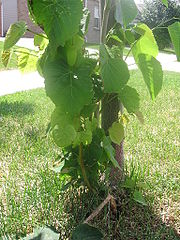
Basal shoot
Encyclopedia


Bud
In botany, a bud is an undeveloped or embryonic shoot and normally occurs in the axil of a leaf or at the tip of the stem. Once formed, a bud may remain for some time in a dormant condition, or it may form a shoot immediately. Buds may be specialized to develop flowers or short shoots, or may have...
at the base of a tree
Tree
A tree is a perennial woody plant. It is most often defined as a woody plant that has many secondary branches supported clear of the ground on a single main stem or trunk with clear apical dominance. A minimum height specification at maturity is cited by some authors, varying from 3 m to...
or shrub
Shrub
A shrub or bush is distinguished from a tree by its multiple stems and shorter height, usually under 5–6 m tall. A large number of plants may become either shrubs or trees, depending on the growing conditions they experience...
or from its root
Root
In vascular plants, the root is the organ of a plant that typically lies below the surface of the soil. This is not always the case, however, since a root can also be aerial or aerating . Furthermore, a stem normally occurring below ground is not exceptional either...
s. This shoot then becomes, or takes the form of, a singular plant. A plant that produces suckers is referred to as surculose. Root suckers may emerge some distance from the originating plant such as in Rhus spp
Sumac
Sumac is any one of approximately 250 species of flowering plants in the genus Rhus and related genera, in the family Anacardiaceae. Sumacs grow in subtropical and temperate regions throughout the world, especially in Africa and North America....
, some Prunus
Prunus
Prunus is a genus of trees and shrubs, which includes the plums, cherries, peaches, apricots and almonds. There are around 430 species spread throughout the northern temperate regions of the globe. Many members of the genus are widely cultivated for fruit and ornament.-Botany:Members of the genus...
species and Embothrium
Embothrium
Embothrium is a genus of two to eight species in the plant family Proteaceae, native to southern South America, in Chile and adjacent western Argentina and southern Peru; the genus occurs as far south as Tierra del Fuego...
species. Suckers also may arise from the stumps of trees that have been cut down. Suckers on some ornamental plants are considered undesirable by horticulturists because the plant's energy is diverted to the sucker rather than to crown growth.
Suckers arising from an unwanted tree stump can be controlled with herbicides such as glyphosate. This kills the entire plant, including suckers and roots.
Suckers on a living plant cannot be removed in the same way as suckers from a stump because the application of an herbicide kills the plant. Horticulturists recommend removing suckers on trees and shrubs by tearing them away as close to the base as possible, removing soil if necessary. The buds that give rise to suckers are more readily destroyed through tearing than through cutting. In extreme cases, the root giving rise to the suckers can be separated from the tree entirely, then treated in the same way as a stump with suckers.
In a grafted
Grafting
Grafting is a horticultural technique whereby tissues from one plant are inserted into those of another so that the two sets of vascular tissues may join together. This vascular joining is called inosculation...
plant, suckers may arise from above the graft or below it. Those arising from the upper part (the scion) may be desirable, but those arising from the rootstock usually are not.

